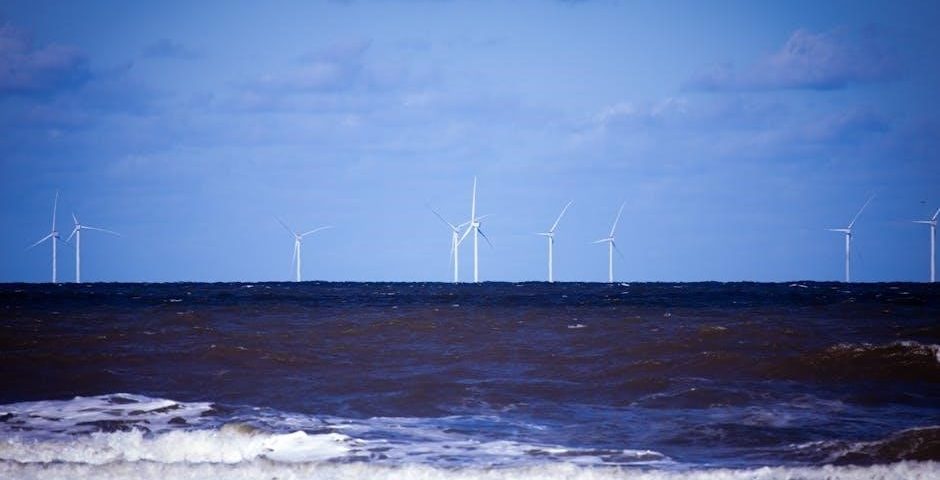This guide provides an overview of electric water heaters, focusing on energy efficiency, environmental impact, and cost considerations. It helps users make informed decisions about selecting and maintaining these systems, balancing performance, eco-friendliness, and long-term savings.
What is an Electric Water Heater?
An electric water heater is a household appliance designed to heat water using electricity. It stores water in an insulated tank or heats it on demand, providing a reliable hot water supply. These heaters are categorized into storage tank models, which keep water hot continuously, and tankless or point-of-use systems, which heat water instantly as needed. Electric water heaters are known for their lower upfront costs compared to gas models and are eco-friendly, producing no direct greenhouse gas emissions. They operate using elements that convert electrical energy into heat, making them a popular choice for energy-conscious homeowners.
Why Energy Efficiency Matters
Energy efficiency is crucial for reducing utility bills and minimizing environmental impact. Electric water heaters with higher energy efficiency consume less power while delivering the same performance. Standby heat loss, a significant factor in energy waste, is reduced in efficient models. By choosing an energy-efficient electric water heater, homeowners can lower their energy consumption, reduce greenhouse gas emissions, and contribute to a more sustainable future. This not only saves money over time but also aligns with eco-friendly practices, making it a responsible choice for modern households.
Understanding Energy Consumption
Electric water heaters consume energy to heat and maintain water temperature. Standby loss, the energy used to keep water hot when not in use, significantly impacts overall consumption. The Energy Factor (EF) measures efficiency, with higher ratings indicating less energy waste. Factors like insulation quality, tank size, and usage patterns also influence energy use. Understanding these elements helps homeowners assess their water heater’s energy demands and identify opportunities for savings, ensuring optimal performance while minimizing energy expenditure.
Types of Electric Water Heaters
Electric water heaters come in storage tank, tankless, and point-of-use models. Storage tank heaters store hot water, while tankless and point-of-use systems heat water on demand, saving space and energy.
Storage Tank Electric Water Heaters
Storage tank electric water heaters are traditional systems that store heated water in an insulated tank. They typically range from 20 to 80 gallons, with larger tanks suitable for bigger households. These heaters use electric elements to heat water, which is then stored for later use. Insulation plays a key role in minimizing heat loss, while standby loss refers to energy wasted when stored water cools over time. The Energy Factor (EF) measures efficiency, with higher ratings indicating better performance and lower energy consumption, making them a reliable choice for consistent hot water supply.
Tankless Electric Water Heaters
Tankless electric water heaters provide hot water on demand without storing it in a tank. They heat water as it flows through the unit, offering continuous supply and space-saving design. These heaters are often installed near the point of use, reducing heat loss and improving efficiency. They are known for their compact size and ability to deliver hot water instantly. While they may have higher upfront costs, tankless models can offer long-term energy savings and extended lifespan compared to traditional storage tank systems, making them a modern and efficient choice for many households.
Instant vs. Point-of-Use Heaters
Instant and point-of-use electric water heaters are designed to provide hot water directly where it’s needed, eliminating the need for storage tanks. Instant heaters are typically larger units that can serve multiple fixtures simultaneously, while point-of-use heaters are smaller, single-purpose appliances installed near specific taps or appliances. Both options offer energy efficiency by heating water only when required, reducing standby loss. However, instant heaters may have higher upfront costs, while point-of-use systems are more affordable but less scalable. Choosing between them depends on household size, water demand, and specific usage patterns for optimal performance and energy savings.

Energy Efficiency Ratings
Energy efficiency ratings for electric water heaters are measured by the Energy Factor (EF), which assesses how efficiently the heater converts electricity into usable hot water. A higher EF indicates better energy efficiency, leading to lower energy bills and reduced environmental impact. Understanding these ratings helps consumers make informed decisions when selecting an eco-friendly and cost-effective water heater.
Energy Factor (EF) Explained
The Energy Factor (EF) measures the efficiency of electric water heaters by calculating the ratio of hot water produced to the energy consumed. A higher EF indicates greater energy efficiency, reducing both utility bills and environmental impact. EF is determined by factors like standby heat loss, recovery efficiency, and cycling losses. Electric water heaters with higher EF ratings are more eco-friendly and cost-effective. Understanding EF helps consumers evaluate performance and make informed decisions when selecting a water heater that balances energy savings and reliability.
Standby Loss and Its Impact
Standby loss refers to the energy wasted when an electric water heater keeps water hot even when not in use. This continuous heating cycle increases energy consumption and utility bills. Higher standby loss leads to lower efficiency and higher operating costs. Measured in watts, standby loss is a key factor in determining a water heater’s overall energy performance. Reducing standby loss through better insulation, timers, or energy-efficient models can significantly lower energy waste and improve cost-effectiveness, making it a critical consideration for eco-conscious and budget-minded households.
Comparing Electric vs. Gas Water Heaters
Electric water heaters are generally more energy-efficient and have lower upfront costs compared to gas models. However, gas water heaters often have lower operating costs, especially in regions with high electricity prices. Electric heaters are easier to install and maintain, while gas heaters require venting and combustion safety measures. Both options have distinct advantages, with electric heaters being quieter and gas heaters providing faster water heating. The choice depends on energy availability, budget, and long-term savings priorities, making it essential to evaluate regional energy costs and personal needs. Proper installation ensures safety and efficiency for both types.
Cost Considerations
Electric water heaters typically have lower upfront costs but may incur higher operating expenses over time. Installation and maintenance costs are generally lower compared to gas models.
Upfront Costs of Electric Water Heaters
Electric water heaters generally have lower upfront costs compared to gas models, with prices ranging from $300 to $1,500, depending on size and features. Installation costs are typically simpler and less expensive due to fewer ventilation requirements. While tankless models may be pricier initially, they offer long-term savings. Additionally, rebates and tax credits for energy-efficient models can reduce initial expenses, making electric water heaters a cost-effective choice for many households.
Operating Costs Over Time
Electric water heaters typically have higher operating costs due to electricity prices, but energy-efficient models can reduce monthly bills. Standby heat loss contributes to ongoing energy consumption, even when hot water isn’t in use. Tankless models generally have lower operating costs over time compared to traditional storage tanks. The Energy Factor (EF) rating plays a significant role in determining long-term expenses. Regular maintenance, such as adjusting temperature settings, can further minimize energy use and lower operating costs, making electric water heaters a viable option for cost-conscious homeowners.
Long-Term Savings Potential
Electric water heaters with high energy efficiency ratings offer significant long-term savings. While upfront costs may be higher, models with advanced features like smart technology and low standby heat loss reduce energy consumption over time. Government incentives, such as rebates and tax credits, further offset initial expenses. Additionally, eco-friendly options like heat pump water heaters qualify for special programs, enhancing savings potential. By investing in energy-efficient systems, homeowners can enjoy lower utility bills and reduced environmental impact, making electric water heaters a cost-effective choice in the long run.

Environmental Impact
Electric water heaters contribute to greenhouse gas emissions, but energy-efficient models reduce environmental impact. Eco-friendly alternatives and renewable energy integration can further minimize their carbon footprint over time.
Greenhouse Gas Emissions
Electric water heaters contribute to greenhouse gas emissions primarily during operation and standby loss; Higher efficiency models reduce emissions by minimizing energy consumption. Using renewable energy sources to power these heaters further lowers their carbon footprint. Upgrading to eco-friendly alternatives, such as heat pump or tankless systems, can significantly reduce environmental impact. Regular maintenance and optimal temperature settings also play a role in minimizing emissions. Choosing energy-efficient electric water heaters is a step toward reducing overall greenhouse gas emissions and promoting sustainability.
Eco-Friendly Alternatives
Eco-friendly alternatives to traditional electric water heaters include heat pump water heaters, tankless systems, and solar water heaters. Heat pump models use ambient heat, reducing energy consumption. Tankless heaters provide on-demand hot water, minimizing standby loss. Solar water heaters harness renewable energy, significantly lowering carbon footprint. These options offer sustainable solutions, reducing reliance on non-renewable energy sources and lowering greenhouse gas emissions. They are ideal for environmentally conscious homeowners seeking to reduce their environmental impact while maintaining efficient water heating.
Reducing Carbon Footprint
Reducing carbon footprint involves choosing energy-efficient electric water heaters and adopting sustainable practices. High-efficiency models, such as heat pump water heaters, significantly lower energy consumption and emissions. Upgrading to eco-friendly systems like solar water heaters can nearly eliminate carbon output. Regular maintenance ensures optimal performance, reducing waste. Additionally, using programmable thermostats and insulation minimizes heat loss. Incentives like rebates encourage homeowners to switch to greener options, further promoting environmental benefits. These strategies collectively contribute to a more sustainable future by minimizing greenhouse gas emissions and energy waste.

Maintenance and Efficiency Tips
Regular maintenance, such as checking the anode rod and inspecting temperature-pressure relief valves, ensures optimal performance. Proper insulation and timely repairs prevent energy waste and extend lifespan.
Regular Maintenance Practices
Regular maintenance is essential for ensuring the efficiency and longevity of electric water heaters. Key practices include checking the anode rod for corrosion, inspecting temperature-pressure relief valves, and ensuring proper insulation. Annual draining of sediment from the tank helps prevent mineral buildup and improves performance. Additionally, monitoring the thermostat settings and adjusting them to optimal levels can reduce energy consumption. Timely repairs of leaks or faulty components prevent major issues. By following these practices, homeowners can maintain their water heaters effectively, reducing energy bills and extending the system’s lifespan.
Optimizing Water Temperature
Optimizing water temperature is crucial for energy efficiency and safety. The ideal setting for most households is between 120°F and 140°F, balancing comfort and energy use. Lowering the temperature reduces standby heat loss and energy consumption. However, it should not drop below 120°F to prevent bacterial growth. Adjusting the thermostat during vacations or periods of low usage can further save energy. Modern electric water heaters often feature precise temperature controls, allowing homeowners to fine-tune settings for optimal performance and energy savings;
Insulation and Heat Loss Prevention
Proper insulation is essential to minimize heat loss in electric water heaters. Wrapping the tank with insulation materials like foam or reflective blankets reduces standby heat loss. Insulating exposed hot water pipes, especially near the heater, further enhances efficiency. Ensuring the surrounding area is well-insulated, particularly in unheated spaces, prevents unnecessary heat dissipation. Regularly checking and maintaining insulation helps retain heat, lowering energy consumption and extending the system’s lifespan while reducing operational costs.
Safety Features
Electric water heaters include thermostats for temperature control, pressure relief valves to prevent overpressure, and advanced sensors to detect leaks and overheating, ensuring safe operation and protection.
Thermostats and Temperature Control
Thermostats in electric water heaters regulate water temperature, ensuring consistent heat output while preventing scalding. Modern models often feature digital controls for precise adjustments. These systems help maintain energy efficiency by avoiding excessive heating. Some advanced thermostats include smart technology, allowing users to set schedules or monitor temperatures remotely. Proper temperature control not only enhances safety but also optimizes energy consumption, reducing standby heat loss. Regular thermostat calibration ensures accurate performance, while tamper-proof designs prevent accidental changes, making them a crucial safety and efficiency feature in electric water heaters.
Pressure Relief Valves
Pressure relief valves are essential safety components in electric water heaters, designed to release excess pressure buildup inside the tank. They prevent potential explosions or damage by automatically opening when pressure exceeds a preset level. Proper installation and regular maintenance are crucial to ensure these valves function correctly; Homeowners should check for leaks or damage and replace worn-out valves promptly. Regular inspections help maintain safety and efficiency, preventing costly repairs. These valves are a critical safeguard against hazards, ensuring the system operates within safe pressure limits at all times.
Leakage and Overheating Protection
Modern electric water heaters often feature advanced leakage and overheating protection systems to prevent damage and ensure safe operation. These systems include thermal cutoffs, emergency shutoffs, and moisture detection sensors that alert users to potential issues. Regular inspections of temperature and pressure relief valves, along with proper installation, are crucial to prevent leaks. Overheating protection mechanisms, such as thermostats and smart sensors, help maintain optimal water temperatures while minimizing energy waste. These safeguards not only protect the appliance but also enhance user safety and overall system efficiency.
Modern Advancements
Electric water heaters now feature cutting-edge technologies like advanced insulation, smart controls, and eco-friendly designs, enhancing efficiency and user convenience while reducing environmental impact.
Smart Water Heaters
Smart water heaters integrate advanced technology for enhanced efficiency and convenience. They feature Wi-Fi connectivity, allowing users to monitor and control temperature settings via smartphone apps. These systems learn usage patterns to optimize energy consumption, reducing waste. Some models offer voice assistant compatibility, enabling hands-free adjustments. Smart heaters also provide real-time energy usage insights, helping users identify savings opportunities. Additionally, they can integrate with smart home systems, ensuring seamless operation and improved energy management. These innovations make smart water heaters a cutting-edge choice for modern, eco-conscious households.
Remote Monitoring and Control
Remote monitoring and control systems allow users to manage their electric water heaters through smartphone apps or web platforms. This technology enables real-time tracking of energy consumption, temperature adjustments, and operational status. Users can receive alerts for leaks, overheating, or unusual activity, ensuring timely interventions. Remote control features also let users switch modes, optimize settings, or turn the heater off when not in use. This level of oversight enhances convenience, energy efficiency, and system longevity, making remote monitoring a valuable tool for modern households aiming to reduce energy waste and lower utility bills.
Integration with Smart Home Systems
Electric water heaters can now seamlessly integrate with smart home systems, enhancing convenience and energy management. Compatibility with platforms like Samsung SmartThings or Apple HomeKit allows users to control their water heaters via voice commands or smartphone apps. This integration enables features such as scheduling, remote diagnostics, and energy usage tracking. By connecting to smart home hubs, users can optimize energy consumption based on their daily routines. Voice assistants like Alexa or Google Assistant further simplify operations, making it easier to adjust settings or monitor performance. This integration not only improves efficiency but also enhances overall home automation experiences.

Government Incentives
Government incentives, such as rebates and tax credits, encourage the adoption of energy-efficient electric water heaters. These programs aim to reduce energy consumption and promote eco-friendly technologies.
Rebates and Tax Credits
Rebates and tax credits are government incentives designed to encourage the adoption of energy-efficient electric water heaters. These programs help offset the upfront costs of purchasing and installing eco-friendly systems. Federal tax credits often cover a portion of the expenses for high-efficiency models, while state and local rebates provide additional savings. Many utilities also offer rebates for energy-efficient appliances, further reducing the financial burden. By taking advantage of these incentives, homeowners can enjoy both immediate savings and long-term benefits from reduced energy consumption.
Energy Efficiency Programs
Energy efficiency programs are initiatives designed to promote the use of high-efficiency electric water heaters. These programs often include rebates, tax credits, and educational campaigns to encourage homeowners to adopt eco-friendly systems. By participating in these programs, consumers can reduce their energy consumption and lower their utility bills. Additionally, many utilities partner with government agencies to offer incentives for upgrading to energy-efficient models, further supporting the transition to greener technologies.
State and Federal Incentives
State and federal incentives are designed to encourage the adoption of energy-efficient electric water heaters. These programs often include rebates, tax credits, and grants to offset the upfront costs of purchasing and installing high-efficiency models. For example, the U.S. Department of Energy offers incentives for energy-efficient appliances, while state-level programs may provide additional rebates. These incentives not only help reduce initial expenses but also promote the use of eco-friendly technologies. By taking advantage of these programs, homeowners can save money while contributing to a more sustainable future. Always check local government websites for available incentives in your area.
Selecting the right electric water heater balances energy efficiency, cost, and environmental impact. By considering these factors, homeowners can enjoy long-term savings and reduced carbon footprints while supporting sustainable practices.
Final Thoughts on Energy Efficiency
Energy efficiency is a cornerstone of modern electric water heaters, offering significant long-term savings and environmental benefits. By understanding factors like Energy Factor (EF) ratings and standby loss, consumers can make informed decisions. High-efficiency models reduce energy consumption while maintaining performance. Regular maintenance, such as optimizing water temperature and preventing heat loss, further enhances efficiency. Balancing upfront costs with long-term savings ensures a sustainable and cost-effective solution for homeowners. Prioritizing energy efficiency not only lowers utility bills but also contributes to a greener future.
Choosing the Right Electric Water Heater
Selecting the ideal electric water heater involves assessing your household’s needs, budget, and preferences. Consider factors like household size, water usage patterns, and available space. Compare storage tank and tankless models based on their benefits—tankless offers continuous hot water but may have higher upfront costs. Check Energy Factor (EF) ratings for efficiency and evaluate standby loss. Balance initial investment with long-term energy savings. Eco-friendly options, such as heat pump water heaters, may also align with sustainability goals. Prioritize models with advanced features like smart controls for optimal performance.
Future Trends in Water Heater Technology
Advancements in electric water heater technology are expected to focus on enhanced efficiency, connectivity, and sustainability. Smart water heaters with remote monitoring and control via smartphones are gaining popularity, allowing users to optimize energy usage. Integration with smart home systems and voice assistants is becoming more common. Heat pump water heaters are likely to dominate due to their high efficiency. Additionally, government incentives for eco-friendly alternatives, like solar water heaters, will drive adoption. These innovations aim to reduce energy consumption, lower greenhouse gas emissions, and provide cost savings for consumers.
